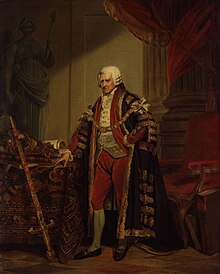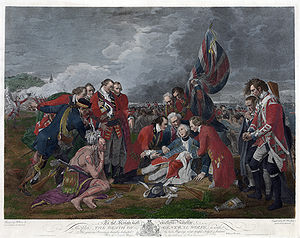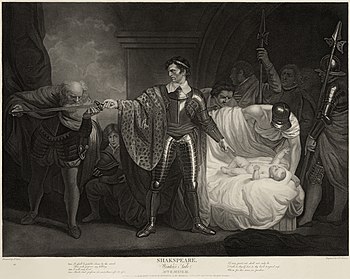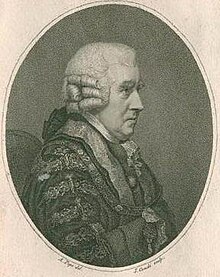John Boydell
He helped alter the trade imbalance between Britain and France in engravings and initiated an English tradition in the art form.
The son of a land surveyor, Boydell apprenticed himself to William Henry Toms, an artist he admired, and learned engraving.
Ten years later, largely as a result of Boydell's initiative, the trade imbalance had shifted, and he was named a fellow of the Royal Society for his efforts.
Throughout his life, Boydell dedicated time to civic projects: he donated art to government institutions and ran for public office.
A year later, like many other enterprising young men of the time, Boydell resolved to sail to the East Indies in hopes of making his fortune, but he abandoned the scheme in favour of returning to Flintshire and Elizabeth Lloyd, the woman he was courting.
[2][4] In either 1740 or 1741, Boydell saw a print of Hawarden Castle by William Henry Toms and was so delighted with it that he immediately set out again for London to learn printmaking and Lloyd promised to wait for him.
[11] He was not subject to the whims of public taste: if his engravings did not sell well, he could supplement his earnings by trading in the prints of other artists.
"[2][18] In 1761, Boydell decided that he would attempt to trade with the French in kind—something they had refused in the past because of the poor quality of British engravings.
[2] Woollett had already successfully engraved Claude Lorrain's 1663 painting The Father of Psyche Sacrificing at the Temple of Apollo for Boydell in 1760.
Unlike "his competitors [who sold manuals, atlases and other assorted books] ... his [business had an] almost exclusive concentration on the sale of reproductive prints".
[2][3] As early as 1767, Boydell had stopped engraving prints himself and began exclusively relying on commissions and trades and it was from these that he profited.
[23] In 1773, he began A Set of Prints Engraved after the Most Capital Paintings in the Collection of Her Imperial Majesty the Empress of Russia, Lately in the Possession of the Earl of Orford at Houghton in Norfolk, which was finished in 1788.
[2] In addition to these projects and in the middle of his Shakespeare undertaking Boydell experimented with aquatint in An History of the River Thames, published in 1796.
Bruntjen writes, "although not the first colored aquatint book, [it] was the first major one, and it was to set an example for the type of illustration that was to enjoy widespread popularity in England for some forty years".
[16] In 1789, at the Royal Academy dinner, the Prince of Wales toasted "an English tradesman who patronizes art better than the Grand Monarque, Alderman Boydell, the Commercial Maecenas".
[31] The edition was financed through a subscription campaign in which the buyers would offer partial payment up front and then pay the remaining sum on delivery.
[34] To illustrate the edition and to provide images for the folio, Boydell obtained the assistance of the most eminent painters and engravers of the day.
Two reviews from the most influential newspapers in London at the time solidified and validated the public's interest in the project and the artists' efforts.
[39] The folio, which collected together the engravings from the paintings, has been the most lasting legacy of the Boydell enterprise: it was reissued throughout the 19th century and scholars have described it as a precursor to the modern coffee table book.
In the preface, he explained why he had made such large gifts: It may be a matter of wonder to some, what enducements I could have to present the City of London with so many expensive Pictures; the principal reasons that influence me were these: First: to show my respect for the Corporation, and my Fellow Citizens, Secondly: to give pleasure to the Public, and Foreigners in general, Thirdly: to be of service to the Artists, by shewing their works to the greatest advantage: and, Fourthly: for the mere purpose of pleasing myself.
He was appealing to his fellow tradespeople and craftspeople with these gifts, a middle class which would have been only too pleased to see their values promoted by such a prominent figure.
[44] In a speech before the Council to advocate the renovation of a building for the purpose of displaying public art, Boydell made the striking claim that if the rich could be persuaded to patronise art, they would forgo their wicked ways: one might be found amongst the many spendthrifts of the present age, instead of ruining themselves by gaming, or laying snares to debauch young Females, by their false promises and many other bad vices; would be rejoiced at such an opportunity, of reclaiming themselves by withdrawing from the snares laid for them by bad and designing Men and Women, who constantly lay wait to lead astray the young and unwary that are possessed of large property, such might here have the pleasure and satisfaction to make a real Paradise on earth, by illuminating a place that would for ever shine and display their generosity.
[2] According to Josiah, John Boydell caught a cold by going to the Old Bailey on a damp, foggy day to do his duty as an alderman.
He was buried on 19 December 1804 at the Church of St. Olave Old Jewry, his funeral attended by the Lord Mayor, aldermen, and several artists.
[48] Boydell had, almost single-handedly, made British prints a viable economic commodity and had demolished the French domination of the trade.
In a letter to Sir John Anderson, asking Parliament for the private Lottery Act to sell off the Shakespeare Gallery, Boydell stated that it was "sufficient to say, that the whole course of that commerce [print trade] is changed".
According to Bruntjen, "it was due to the enthusiasm of Boydell and others that the English government eventually provided funds for the establishment of the National Gallery in 1824".
He "attempted to free artists from the traditional forms of state and aristocratic patronage by creating a public taste for reproductive prints of historical subjects".
[12] Boydell's entry in the Dictionary of National Biography ends with the assessment that "no print publisher before or since has ever exerted as much influence on the course of British art".








